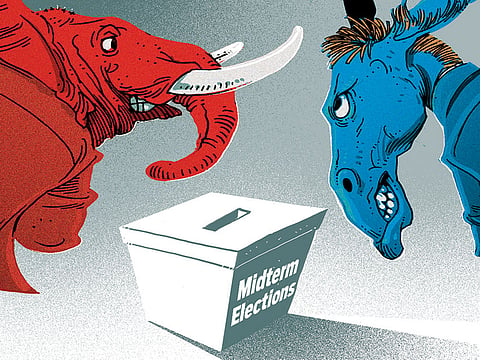US midterms can swing either way
The question in the upcoming election is whether liberal enthusiasm or Republican satisfaction with Trump will prevail

The 2016 presidential election in the US shredded the old rule book on how American elections are fought and won. Now a few weeks before the midterm elections, when all of the seats in the House of Representatives and a third of the seats in the Senate are contested, we still don’t know what the new rules look like. In normal times, midterms are an opportunity for the electorate to express buyer’s remorse. Two years after they vote for a president, they are either disappointed he hasn’t done enough of what they wanted or angry because he’s done too much of what they didn’t want. So they take it out on his party.
Democrats should be a shoo-in to take back the House. Four of the largest five demonstrations in US history have taken place in the last two years. They have all been either against Donald Trump’s presidency or key elements of his agenda. On the left, voter enthusiasm is at a record high.
A year after #MeToo and a month after a bitter supreme court nomination that focused on sexual assault, Democrats are running a record number of women candidates for the House and Senate. Moreover, a fifth of those female House candidates are under 40 and a third are women of colour. But these are not normal times.
The question in this election is which of the moods will prevail in November. On the one hand, to what extent will the growing militancy and anxiety among progressives translate into votes for a party that as of yet has no clear leader or agenda? On the other, will the inchoate coalition of discontent and self-interest that comprises Trump’s base turn out for a party that never wanted him in a moment when he is on everybody’s minds but not on the actual ballot?
In 2016, Bill Clinton used to tell Hillary’s campaign operatives what he was hearing on the ground only to be routinely ignored. “[The] response was always a variation on the same analysis: the data run counter to your anecdotes,” wrote Jonathan Allen and Amie Parnes in Shattered: Inside Hillary Clinton’s Doomed Campaign. “Bill liked data, but he believed it was insufficient … He felt it was important to talk to voters and get a real sense for what they were feeling.”
To get a sense of what the voters are feeling this time I have come to cover the midterms from Racine, Wisconsin, a small post-industrial town of 80,000 that sits on the West Coast of Lake Michigan between Chicago and Milwaukee. I chose Racine for three reasons. First, it sits in a swing county. Second, it sits in the district of the Republican House speaker Paul Ryan, who is stepping down. The district is favoured for Republicans — Trump won it by 10 points — but it remains competitive and is the kind of seat Democrats need to win to take the House. A New York Times/Siena College poll last month gave Republicans a six-point lead here: but then that’s precisely the average poll lead Clinton had in Wisconsin a week before the 2016 election — and she lost.
Which brings us to the final reason: Wisconsin. Lake Michigan, Democrats thought they had it in the bag and made little effort there only to lose narrowly — the first time Wisconsin had backed a Republican for more than three decades. But also Wisconsin’s recent political history resonates with this moment.
In 2010 it elected Scott Walker, a Republican governor pursuing a hardline conservative agenda. His plan to end collective bargaining rights for public sector unions and cut local government workers’ health benefits and pension entitlements in order to balance the budget sparked huge protests. Before Occupy Wall Street, tens of thousands of Wisconsinites occupied the state capitol in huge protest against austerity — it was the resistance before the resistance had a name. Collecting more than 900,000 signatures, they forced Walker to be recalled — in other words, he faced a revote on his governorship.
When I reported from that election, progressives claimed Walker won on false pretences and people did not know what they were getting. Now it was clear they would reject him. A week before the election I met the Democratic state representative for Racine, Cory Mason. “When I meet people now I feel there was as much of a sense of urgency and real intensity as I’ve ever seen,” he said then. But little more than a week later, Walker was re-elected with an increased majority. Walker is still the governor, and this year he faces yet another tough challenge. Mason is now the mayor of Racine.
— Guardian News & Media Ltd
Gary Younge is a noted columnist. He is the editor-at-large for the Guardian.
Sign up for the Daily Briefing
Get the latest news and updates straight to your inbox



